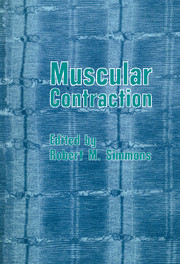Book contents
- Frontmatter
- Contents
- Dedication
- Contributors
- Preface
- 1 A. F. Huxley: an essay on his personality and his work on nerve physiology
- 2 A. F. Huxley's research on muscle
- 3 Ultraslow, slow, intermediate, and fast inactivation of human sodium channels
- 4 The structure of the triad: local stimulation experiments then and now
- 5 The calcium-induced calcium release mechanism in skeletal muscle and its modification by drugs
- 6 Hypodynamic tension changes in the frog heart
- 7 Regulation of contractile proteins in heart muscle
- 8 Differential activation of myofibrils during fatigue in twitch skeletal muscle fibres of the frog
- 9 High-speed digital imaging microscopy of isolated muscle cells
- 10 Inotropic mechanism of myocardium
- 11 Regulation of muscle contraction: dual role of calcium and cross-bridges.
- 12 Fibre types in Xenopus muscle and their functional properties.
- 13 An electron microscopist's role in experiments on isolated muscle fibres.
- 14 Structural changes accompanying mechanical events in muscle contraction.
- 15 Mechano-chemistry of negatively strained cross-bridges in skeletal muscle.
- 16 Force response in steady lengthening of active single muscle fibres.
- References
- Index
14 - Structural changes accompanying mechanical events in muscle contraction.
Published online by Cambridge University Press: 07 September 2010
- Frontmatter
- Contents
- Dedication
- Contributors
- Preface
- 1 A. F. Huxley: an essay on his personality and his work on nerve physiology
- 2 A. F. Huxley's research on muscle
- 3 Ultraslow, slow, intermediate, and fast inactivation of human sodium channels
- 4 The structure of the triad: local stimulation experiments then and now
- 5 The calcium-induced calcium release mechanism in skeletal muscle and its modification by drugs
- 6 Hypodynamic tension changes in the frog heart
- 7 Regulation of contractile proteins in heart muscle
- 8 Differential activation of myofibrils during fatigue in twitch skeletal muscle fibres of the frog
- 9 High-speed digital imaging microscopy of isolated muscle cells
- 10 Inotropic mechanism of myocardium
- 11 Regulation of muscle contraction: dual role of calcium and cross-bridges.
- 12 Fibre types in Xenopus muscle and their functional properties.
- 13 An electron microscopist's role in experiments on isolated muscle fibres.
- 14 Structural changes accompanying mechanical events in muscle contraction.
- 15 Mechano-chemistry of negatively strained cross-bridges in skeletal muscle.
- 16 Force response in steady lengthening of active single muscle fibres.
- References
- Index
Summary
Introduction
My first degree was in physics, but I became interested in the structure of biological macromolecules in my final year, and went on to do a Ph.D. in protein crystallography. I found it very frustrating having to wait for crystals to grow and decided to change to a research area where I could go into the laboratory in the morning and do a new experiment. The easiest option was to change to fibre diffraction, and muscle seemed a good thing to work on as its structure was less well worked out than many of the other fibrous proteins. However, somewhere along the way to securing a postdoctoral position, I was given an introduction to Andrew Huxley, then head of the Department of Physiology at University College London (UCL), who persuaded me to think seriously about a career in physiology. So I did an M.Sc. in Physiology at UCL and ended up doing a project in Prof's laboratory. My project was to investigate a recent report that the internal resistivity of muscle fibres changed during contraction (it didn't).
After that I joined Prof in his research on the mechanical properties of muscle fibres, taking over where Fred Julian had left off (see Chapter 2). It took several years to make the length step experiments on muscle fibres that led to the cross-bridge theory paper in 1971 (A. F. Huxley & Simmons, 1971b), and the really quantitative experiments were not done until Lincoln Ford arrived.
- Type
- Chapter
- Information
- Muscular Contraction , pp. 203 - 218Publisher: Cambridge University PressPrint publication year: 1992
- 1
- Cited by



